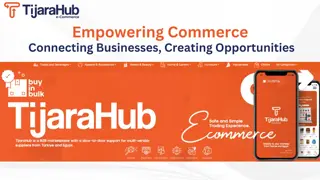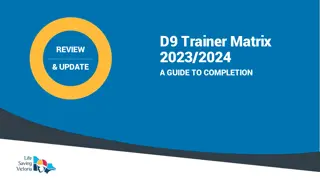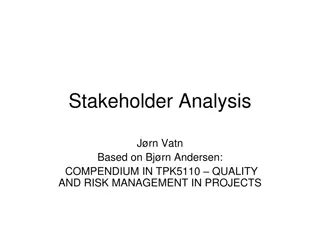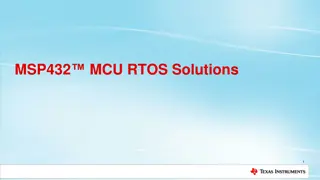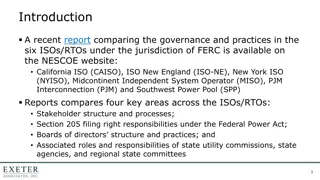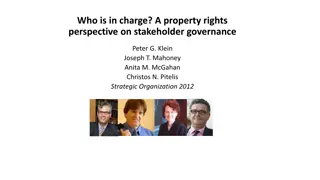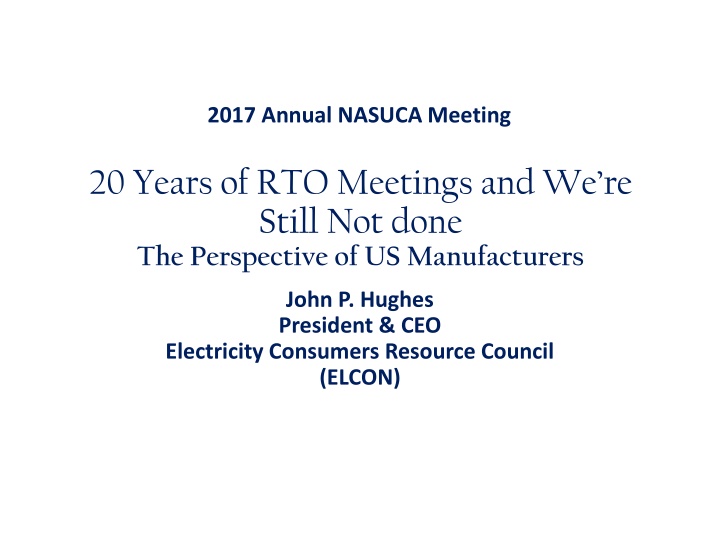
Perspective of US Manufacturers on RTOs and Stakeholder Process in Energy Industry
The article delves into the history and challenges of Regional Transmission Organizations (RTOs) in the energy sector, focusing on the viewpoint of US manufacturers. It discusses the evolution of RTOs, debates around Locational Marginal Pricing (LMP), stakeholder meetings, and concerns related to market design and consumer interests.
Download Presentation

Please find below an Image/Link to download the presentation.
The content on the website is provided AS IS for your information and personal use only. It may not be sold, licensed, or shared on other websites without obtaining consent from the author. If you encounter any issues during the download, it is possible that the publisher has removed the file from their server.
You are allowed to download the files provided on this website for personal or commercial use, subject to the condition that they are used lawfully. All files are the property of their respective owners.
The content on the website is provided AS IS for your information and personal use only. It may not be sold, licensed, or shared on other websites without obtaining consent from the author.
E N D
Presentation Transcript
2017 Annual NASUCA Meeting 20 Years of RTO Meetings and We re Still Not done The Perspective of US Manufacturers John P. Hughes President & CEO Electricity Consumers Resource Council (ELCON)
RTOs: Where Did They Come From In 1922, Pennsylvania Governor Gifford Pinchot coined the term Giant Power a proposed power pool for the entire Northeastern United States. Following EPAct 1992, interest in retail-level competition in electric services miraculously began to dominate the energy policy space. Later the 1994 California Blue Book proceeding identified two alternative restructuring models: 1. Poolco (with Locational Marginal Pricing) 2. Direct Access Both California models required an ISO.
ISOs & LMP ELCON was one of many stakeholder groups that opposed the Poolco model. ELCON comments to the CPUC: might work in theory but regulators would never allow it to work as intended. The dirty secret about LMP is that it required scarcity pricing and what the market will bear! 2000-2001 California Energy Crisis was sufficient vindication. Price caps were locked it.
RTOs & LMP The nexus of the modern RTO framework and LMP pricing has condemned the RTO stakeholder process to death by meetings. Some RTOs have over 300 stakeholder meetings per year. A large US manufacturer might have one or two electricity buyers some with global responsibilities. We have created a competitive framework in which transaction costs are maximized.
Stakeholder Process Animus The RTO market design has never and may not ever be stabilized and therefore the stakeholder process will forever be the resource hog it is today. This does not bode well for consumer interests because the market design tinkering is always about missing money sticking more costs (legitimate or not) on consumers. The current driver of market design changes price formation and the DOE NOPR is very low cost Shale gas. There seems to be a conspiracy to deny consumers the benefit of this resource.
Concerns with the RTO Stakeholder Processes Governance State Influence Participation Incumbent and New-Entrant Participation Sector Voting Filing Second-Best Proposals with FERC Principal-Agent Problem FERC s Role in Requiring J&R Rates Source: Mark James et al., How the RTO Stakeholder Process Affects Market Efficiency, R Street Policy Study No. 112, October 2017





